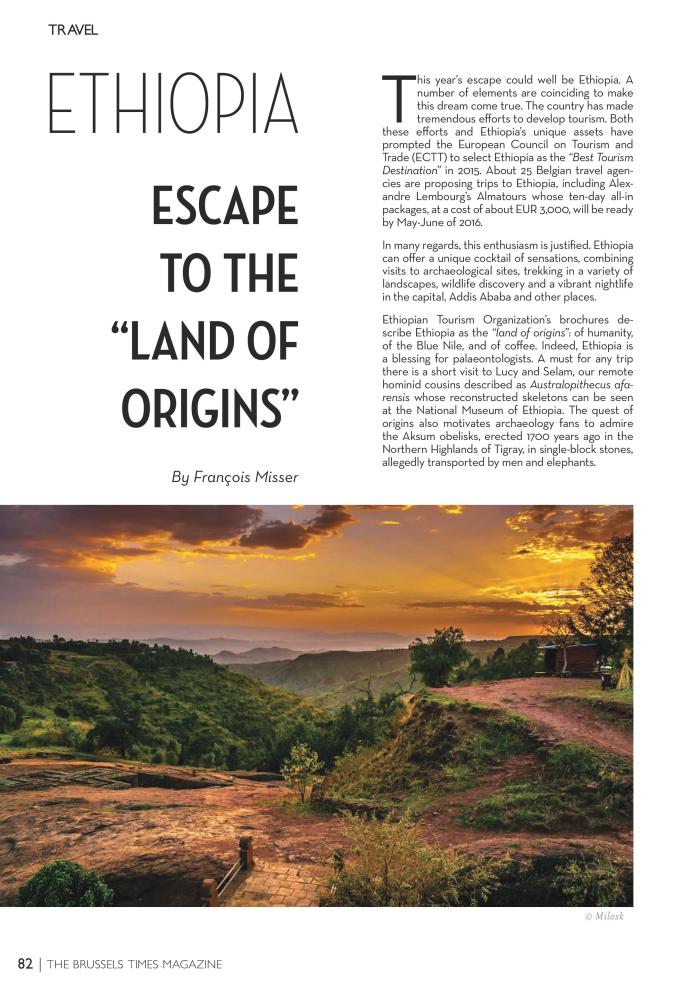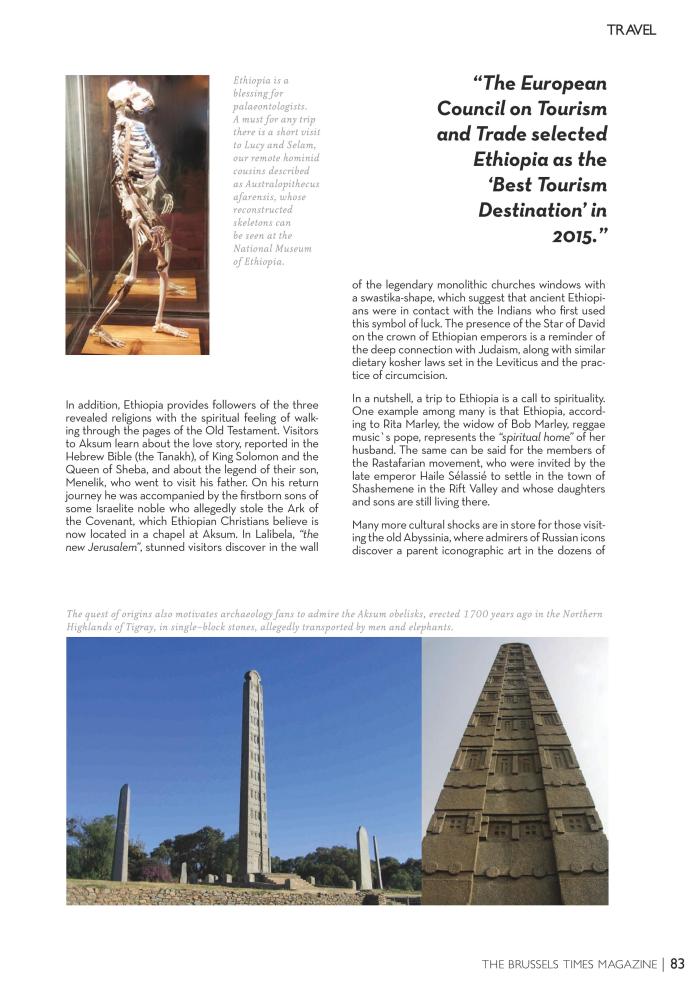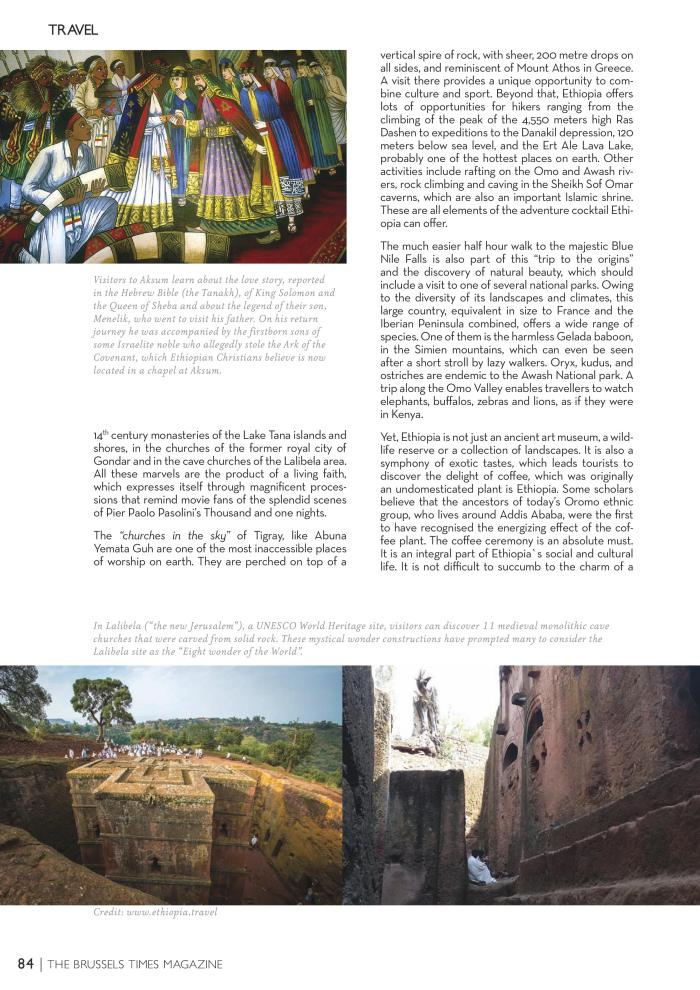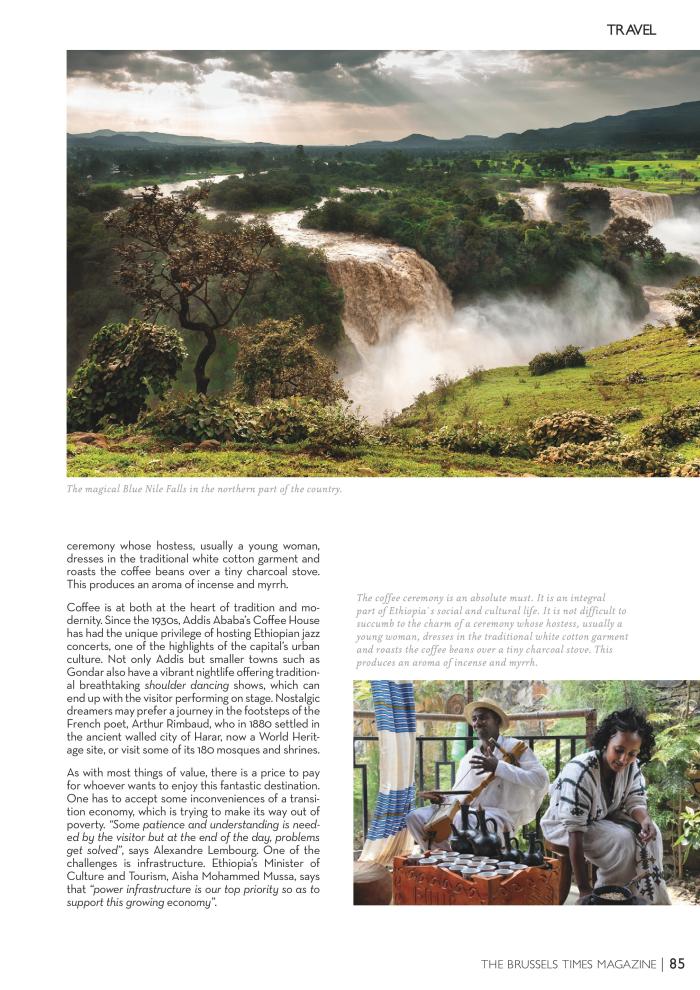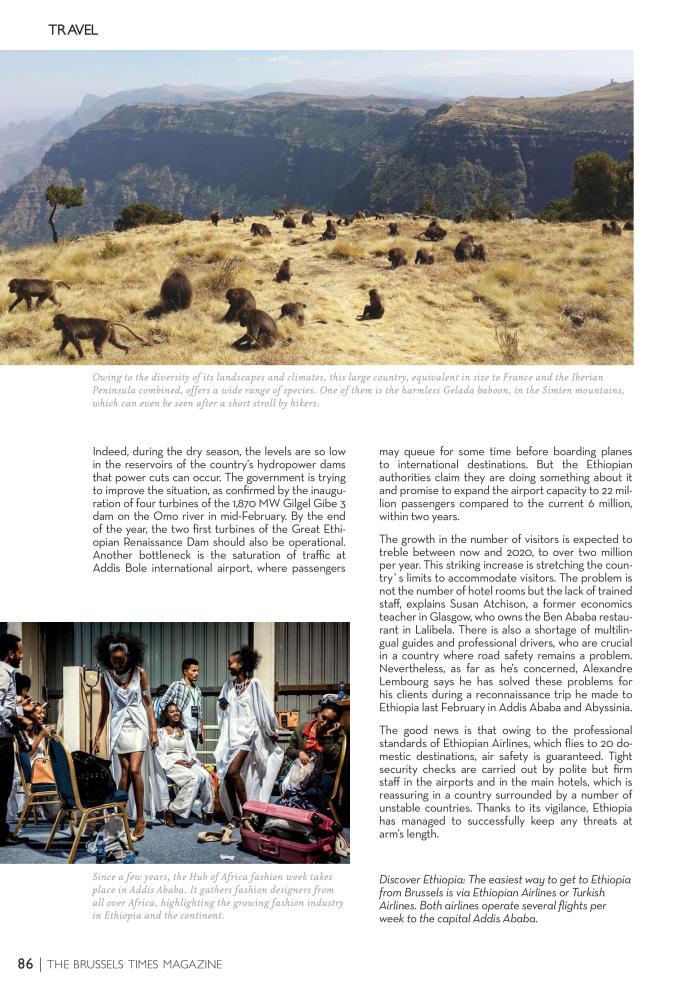Posts Tagged ‘Travel’
Divine Ethiopia
Source: http://www.telegraph.co.uk/luxury/travel/72794/divine-ethiopia-religion-churches-and-incredible-travel-sights.html (May 29th 2015 by Stanley Stewart)
Ethiopia “resembles no other country in Africa”, wrote the great explorer Wilfred Thesiger, “or anywhere else.”

Exploring Ethiopia by helicopter
Sunday Service in the church of Abuna Yemata Guh requires nerves of steel. Yet they assured me the congregations were good. “Don’t worry,” the priest fussed. “Pregnant women are attending, old people are attending, tiny children are attending.”
I wasn’t sure I would be attending. I was standing on a narrow ledge. Below me was a 1,000ft drop to the valley floor. Somewhere above me, beyond a sheer polished cliff, was the church. My legs felt like water. I was sweating in places I had never sweated before. At that moment, the eye of a needle seemed easier to negotiate. “You must try,” the priest whispered. “God is watching.”
There are moments when Ethiopia seems to belong to an atlas of the imagination – part legend, part fairy-tale, part Old Testament book, part pulling your leg. In this land of wonders there are medieval castles of a black Camelot, monasteries among Middle Earth peaks accessible only by rope and chains, the ruined palace of the Queen of Sheba and the original Ten Commandments in a sealed box guarded by mute monks with killer instincts.
In the northern highlands priests with white robes and shepherds’ crooks appear to have stepped out of a Biblical painting. In the southern river valleys bare-breasted tribeswomen, who scar their torsos for erotic effect and insert plates the size of table mats in their lower lips, seemed to have emerged from a National Geographic magazine circa 1930. Ethiopia “resembles no other country in Africa”, wrote the great explorer Wilfred Thesiger, “or anywhere else.”
Its isolation is legendary. Not only was Ethiopia never colonised, but it also inflicted the greatest defeat on a European army in the history of the continent – at the Battle of Adwa in 1896. It was only the Italians, of course, but it still counts. Ethiopians were “forgetful of the world”, Edward Gibbon wrote, “by whom they were forgotten”. For long medieval centuries Europeans believed that Ethiopia was home to Prester John, legendary Christian ruler, descendant of one of the three Magi, keeper of the Fountain of Youth, protector of the Holy Grail, and all-round good guy who would one day rescue the Holy Land from the Muslims.
Crossing the threshold of the church of Medhane Alem in Lalibela , I seemed to step back a thousand years. Cut by shafts of dusty light from high windows, the interior gloom was scented with frankincense. I came round a pillar to find a dozen priests leaning on their croziers, chanting in Ge’ez , a language no one has spoken since the Middle Ages. The sound was a curious cross between Gregorian plainsong and a nasal Arabic call to prayer. These were among the earliest Christian rites, unchanged for well over 1,500 years. Worshippers sat on the ground against the bare stone walls, wearing clothes that wouldn’t have been out of place in the Book of Genesis. They gazed mournfully at a pair of threadbare theatrical curtains. Beyond the curtains lay the inner sanctum, the Holy of Holies , which held the Ark of the Covenant .
For a country with so much to offer, it is surprising to find tourism in Ethiopia still in its infancy. The war and famine of the 1970s and 80s, though now almost ancient history, may be partly responsible. But a deeper issue may be a feature of the national character – a lack of entrepreneurial urgency. Ethiopia may not be big on stylish boutiques hotels, littered with objets d’art and architectural magazines, but it is a delightfully old-fashioned place, with ravishing landscapes, sleepy villages and friendly, unhurried people.
It is difficult to pick a single destination from Ethiopia’s treasure chest, but first-time visitors shouldn’t miss Lalibela and its remarkable churches, all below ground level, and all carved from the rock as entire buildings with surrounding courtyards, exterior walls and roofs. Historians are uncertain about much of their history but Ethiopians have a handle on it. A celestial team of angels came in at night to help out after the terrestrial workforce had clocked off.
There are always two histories in Ethiopia: the history of historians, sometimes a trifle vague, often tentative; and the history of Ethiopians, a people’s history, confident, detailed, splendid, often fantastical. The two rarely coincide. Historians are still wringing their hands about the mysteries of Aksum in Tigray in the north, with its colossal stelae, its underground tombs, its ruined palaces and its possible connections to the Queen of Sheba. For a thousand years, until about AD 700, it was a dominant power in the region, “the last of the great civilisations of antiquity”, according to Neville Chittick , the archaeologist, “to be revealed to modern knowledge”.
Fortunately, the Ethiopians are on hand to fill in most of the historical blanks. The city was founded, they say, by the great-grandson of Noah. For 400 years it was ruled by a serpent who enjoyed a diet of milk and virgins. Historians may be divided about the Queen of Sheba but Ethiopians know she set off from here to Jerusalem with 797 camels and lot of rather racy lingerie to seduce King Solomon. Historians carelessly lost track of the Ten Commandments not long after Moses came down from Mount Sinai. Ethiopians have the originals under lock and key in a chapel in Aksum, guarded by those mute monks, assigned to kill all intruders.
The landscapes of Tigray are appropriately Biblical. It is a world where everything comes and goes by foot or hoof, a world of timeless villages perched beneath vast mesas and plunging ravines, a world where it is possible to imagine startling young men turning water into wine. With my bag loaded onto a Palm Sunday donkey, I set off on a three-day walk down the Erar Valley . I strolled through the latticed shade of eucalyptus trees, past scented banks of sage and mint, past stands of prickly pear and neatly ploughed fields framed by irrigation channels. I rested under the shade of vast fig trees beneath colonies of hornbills, bee-eaters and firefinches. A man in a white robe was winnowing wheat, tossing yellow forkfuls into the air, allowing the wind to take the chaff. Children ghosted out of orchards with home-made toys: a ball of goatskin and twine, a doll of twigs and wool. In the late morning I passed people coming back from the weekly market, two hours’ walk away. They were carrying some of life’s essentials: bags of rice, new sickles, bolts of bright cloth, blocks of salt that had come up from the Danakil Desert by camel caravan. Everyone stopped to greet me with handshakes and smiles.
The trek was part of a new community project. The guides and the transport – my faithful donkey – were provided by local villagers who, with the help of NGOs, have also built hedamos, or guesthouses. There is something special about these Tigrayan guesthouses – their location. Tigray is a mountainous region, characterised by ambas: dramatic, sheer-sided, flat-topped mountains. Most of the treks are easygoing, following the valley floors through pastoral landscapes. But towards the end of each day I started to climb with the guide, following steep paths along narrow rising ledges, to the summits of these anvil-headed ambas.
On the top, we emerged into a whole new world of luminous light and distant views. Here we found our home for the night, the community hedamo, perched in splendid isolation on the lip of a colossal escarpment, perhaps 3,000ft above the landscapes below. The views were breathtaking. We looked straight down, past circling eagles, to the world we had just left – ploughed fields, stone tukuls, eddying sheep, tiny white-robed figures trailing along dust lanes. Farther away, rivers carved swathes of ancient earth, canyons yawned open and valleys tumbled into one another. Farther still, mountains patrolled the horizons. With a slight turn of the head, I took in hundreds of miles.
At Erar and Shimbrety , the stone-built guesthouses, with their little courtyards and roof terraces, were comfortable but basic. Village women prepared delicious Ethiopian dinners that made little concession to Western tastes. The loos, Western-style, were in spartan huts. Washing facilities were wooden buckets of warm water. There was no electricity, just lanterns and candles. Yet these felt like the most luxurious places I had ever stayed. It was the luxury of unique experience, of meeting local villagers on their own ground, of engaging with an ancient way of life, of being far from tourism’s well-trodden trails. And it was the luxury of spectacular location. I have never been anywhere with more stunning views.
At Erar, night came with equatorial suddenness. A troop of gelada baboons , 30 or so strong, made their way home across the summit of the amba after a day’s feeding. They climbed down over the edge of the escarpment to precipitous ledges where they would be safe from leopards. The sun set over distant, mythical-looking mountains. When I turned round, a fat full moon was rising directly behind me. The world seemed to be in perfect balance.
Tigray, too, has its remarkable buildings. Scattered across these mountains are more than 120 ancient churches, most excavated in remote rock-faces like caves. Until the 1960s they were virtually unknown to the outside world. Older than the churches at Lalibela, they are little understood by historians. Which means we are left with the fabulous oral history of the Ethiopians.
Abuna Yemata Guh is one of the more challenging churches to reach. A rock butte soared above us; I was getting a crick in my neck and a serious case of vertigo just looking at it. I imagined, as with the sheer-sided ambas, that there would be some circuitous path, some scrambling route to the top. It was only when we had trekked up from the valley floor and gained the narrow ledge that I began to realise I was going to have to climb a cliff-face, in fact several cliff-faces, to get to church.
A priest was waiting on the ledge, with the kind of morbid face usually reserved for the last rites. He advised me to remove my shoes and socks; bare feet would give me a better grip. It turned out that two men, who I had assumed to be casual passers-by, were in fact there to try to prevent me from plummeting to my death.
We started to climb. My two assistants, one above and one below, guided me to precarious foot- and hand-holds. This was rock climbing without the ropes, the safety harness or the Chris Bonington confidence. Spread-eagled on the cliff-face, clinging to the minor indentations that passed for handholds, I felt a trifle out of my comfort zone. Had I know what was in for, I would probably not have chosen Abuna Yemata Guh for a casual visit.
But once I reached it, I was thrilled I had. The climb might be hair-raising but the church is unmissable.
At the top of the cliff, not daring to look down, I gazed ahead, just in time to see a side-chamber full of bones – the priest insisted they were deceased clerics, not fallen visitors. Then I shuffled along a narrow ledge and came to a cave-like opening. The priest wrestled with a key the size of a cricket bat. A door opened and I stepped into the gloom of the tiny church, hardly larger than a modest drawing room. As my eyes adjusted, I became aware of faces round the walls. Then the priest lit a torch and held it aloft. Suddenly the dark walls were alive with figures: apostles and saints, prophets and the archangels, Mary and the infant Christ. The famous Nine Saints from the Levant , who had brought Christianity to Ethiopia in the fifth century, were here, as was Saint Yared, who wrote so many of the early Ethiopian chants. The builder of this cliff church was here, Abu Yemata, mounted on a horse and accompanied by his nephew Benjamin, who had painted the murals.
The priest, a humble villager, told me the stories that swarmed across these walls. He told the stories as they had been told to him, as they had been handed down from one priest to the next from the earliest days of the Christian era. He referred to the apostles as if they were old friends. He talked of the saints as if they were men who had known his grandparents. He told me about the groom who had neglected Yemata’s horse. Yemata had turned him into a weasel. There, he said, bringing his torch near to the wall, illuminating a small weasel-headed man beneath the horse.
I asked why the church was here, so difficult to access, so high in these cliffs. The priest said it was for reasons of safety – it may well have been built when Christianity was still vulnerable. Then he added: “We are closer to God here, away from our world, and closer to His.” He lifted an ancient text enclosed in an ox-hide satchel from a nail on the wall. He asked if he should say prayers. I said I thought a few words might be a good idea. After all, I still had to get down that cliff-face.
Ethiopia’s wealth of surprises
Source: http://www.todayonline.com/lifestyle/ethiopias-wealth-surprises
February 27th 2014, By Cheong Kamei
The East African country may not be on everyone’s must-visit travel list, but it has a lot to offer
The first time I learnt about Ethiopia was when I watched the video to We Are The World, as images of starving African children with distended bellies flashed across the television screen. And it seems that Ethiopia is still haunted by those powerful images of famine and poverty. The country isn’t exactly on everyone’s must-visit vacation list. To top it off, the costly cocktail of vaccinations I needed — it’s compulsory to be vaccinated against yellow fever, and my doctor advised me to get the meningococcal vaccine and malaria pills — didn’t help put my mind at ease. At first.
As I later found out, giving the country a miss would be a huge pity. Ethiopia is eager to exorcise the ghosts of its past. It wants to show off its beautiful scenery, otherworldly architecture and gracious people. All you need to do is be there.
LIVING IT UP
After a 13-hour red-eye flight from Singapore to capital city Addis Ababa on Ethiopian Airlines, it took another two hours by car to get to resort town and popular day-trip destination Debre Zeit, but it was worth the squeeze through the morning traffic.
Sitting at the restaurant of the Kuriftu Resort And Spa, overlooking Lake Kuriftu, watching people kayak and pelicans swim by, I couldn’t help but feel that Debre Zeit is every bit as gorgeous as vacation hot spots anywhere else in the world. The lush greenery, crater lakes and abundant bird-life are testament to the country’s natural beauty, while the luxurious resort I was at reflected Ethiopia’s current tourist boom.
The temperature at Debre Zeit hovers around the mid-20s (that’s Celsius) throughout the year and the tranquil scene was lulling me to sleep when I caught a whiff of a uniquely heady spice. It was berbere, an indigenous and bright red chilli and spice mix that’s traditionally used in dishes, from steak tartar to lentils and wats (slow-cooked stews). Sweet, fiery and addictively aromatic, it’s easy to see Singaporeans falling in love with it. The ubiquitous staple of Ethiopia, injera, on the other hand, takes some getting used to. This flatbread, made from a grain called teff, is light grey in colour and has a slightly spongy texture — similar to a peanut pancake — and a distinctly sour taste.
FAITH HILL
My next stop was the UNESCO World Heritage Site, Lalibela. “Awe-inspiring” does not come close to describing how impressive Lalibela’s 11 cave churches from the 13th-century are. Built by King Lalibela to be Africa’s alternative to Jerusalem, the churches were not erected from the ground up. Instead, the main structure of each church — complete with windows, door and drainage systems — were painstakingly carved out of living rock.
Nobody knows how exactly it was done, although some scholars speculate it took about 24 years to complete. Seeing the churches, in particular Bete Giyorgis, which is built in the shape of a cross, or Bet Medhane Alem, the world’s largest monolithic church that’s 11.5m deep and almost 34m long, you can understand why the legend goes that angels helped complete this architectural marvel.
It was close to Christmas when I was at Lalibela (in the Ethiopian calendar, it falls on Jan 7), and tens of thousands were making their pilgrimage to this spot. Some perched on rocks to read their Bibles, while others prayed, kissed the crosses that were held by priests or broke down at the sight of the churches. At one church, I witnessed dozens of people tirelessly swaying to the beat of the drummers in their company and chanting hymns in an almost trance-like manner. At every corner were people who had walked for miles — sometimes barefoot — to Lalibela to renew, restore or celebrate their faith. The air of reverence was so intense, it felt intrusive to take photos — it was hard not to feel moved.
RICH IN HISTORY
A 30-minute flight away from Lalibela is Gondar, Africa’s Camelot, and Ethiopia’s royal and ancient historical city. Our first stop was Fasil Ghebbi, a complex of 17th- and 18th-century castles that marked Ethiopia’s first permanent imperial residence. Earthquakes and bombings during World War II damaged some of the buildings, but the Fasilides Castle is by far the best preserved. It was fascinating to hear about Ethiopia’s rich history, but what I really appreciated was how glaringly tourist-free this UNESCO World Heritage Site was. With plenty of space and time to leisurely stroll through the complex, and blue, open skies, Fasil Ghebbi felt almost romantic.
Separate from the complex of castles is Fasilides Bath. The original use of the 50m-long and 30m-wide bath is not known for sure, but it’s now filled with water every Jan 19 to celebrate Timkat, the Orthodox Christian celebration of the baptism of Jesus.
From Gondar, it is a three-hour bus ride to the Simien Mountains, 3,000m above sea level. Its stirring skyline of jagged mountain peaks, sharp gorges and the undulating plateau have drawn comparisons with the Grand Canyon in the United States. Unlike the Grand Canyon though, the only activities offered at Simien Mountain National Park are trekking and cycling. As I was feeling lethargic from the high altitude, trekking seemed like an ideal way to start the day. The pace and trail were manageable and the guide showed us the best spots to take in — and get great photos of — the mountain scenery and rare animals such as Gelada baboons.
It’s amazing how much Ethiopia has to offer tourism-wise. In a week, I’d received a five-star spa treatment at Debre Zeit, experienced a spiritual awakening at Lalibela and marvelled at Ethiopia’s regal past at Gondar. And I’d only seen a teeny part of this country — it’s five times the size of Britain, by the way. And I’m already thinking of returning. I’d love to see national parks such as the Omo National Park (one of the most underrated wildlife sanctuaries in East Africa) or take in the surreal beauty of Sof Omar Cave. Now all I need to do is to get used to eating injera.
